Abstract
A description of the fitness, physical activity of lifestyle, and some aspects of health status and attitudes in a population of male factory workers aged 35-60 is presented as the first part of a report on a study of morbidity in this population. A total of 1394 subjects were included, undergoing medical examination, fitness testing by bicycle ergometry, assessment of body fat, and interview questionnaire. The inter-relation of fitness, body composition, habitual exertion, health risk factors, and attitudes to exercise are discussed. Fitness levels are compared with those reported in other studies and discussed in terms of capacity for walking and running and in relation to criteria for health benefit. In these two latter respects fitness appears to be inadequate among the great majority of those tested, although it is comparable with that reported by several other recent studies. Fitness is associated with physical activity of leisure but not that of work. Only relatively strenuous physical activity in leisure time appears to be related to fitness, and is only participated in by some 28% of the sample. Cycling has the strongest association with fitness of all the physical activity variables. Blood pressure and percentage body fat are also associated, inversely, with fitness, the latter not unexpectedly because of the weight related measure of fitness.
Full text
PDF
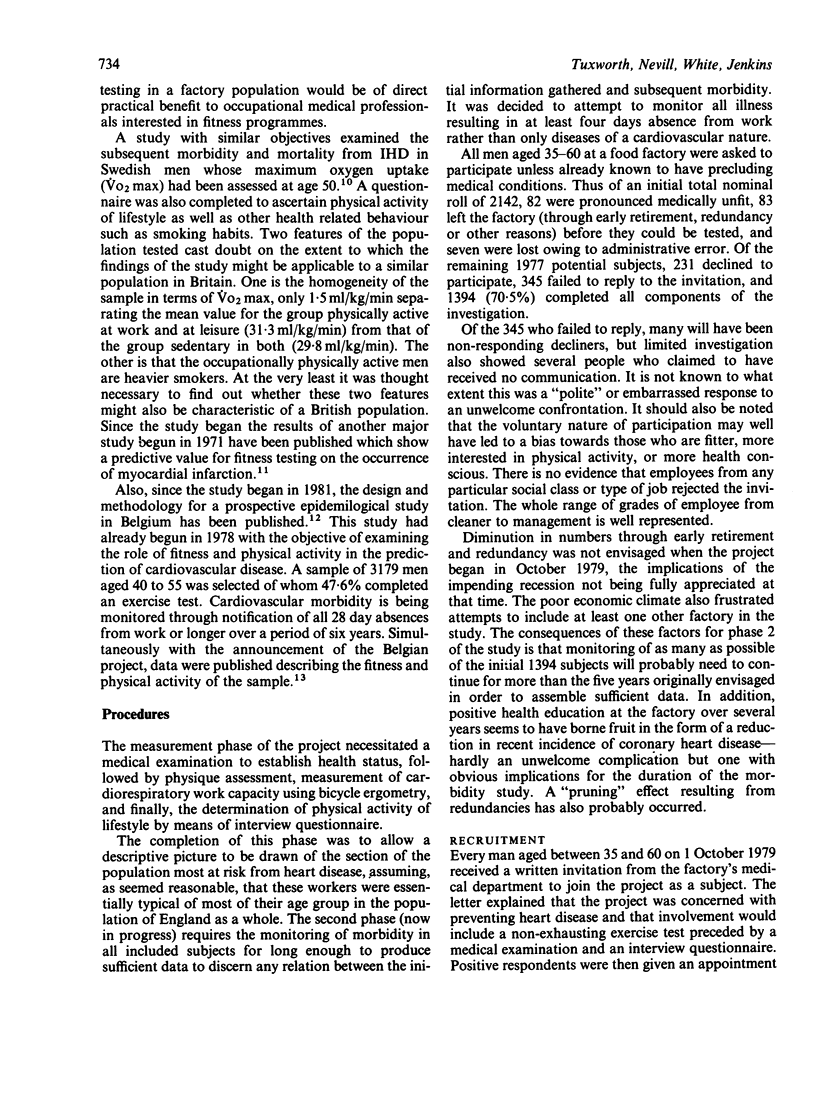



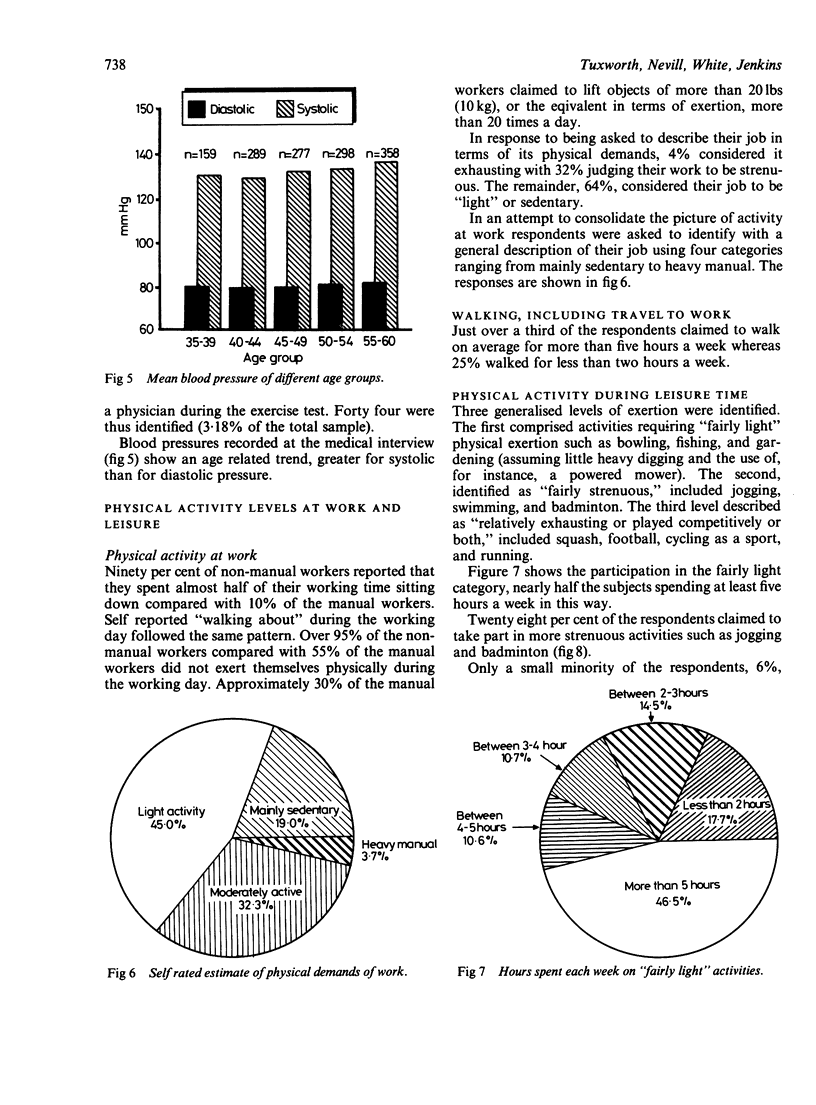
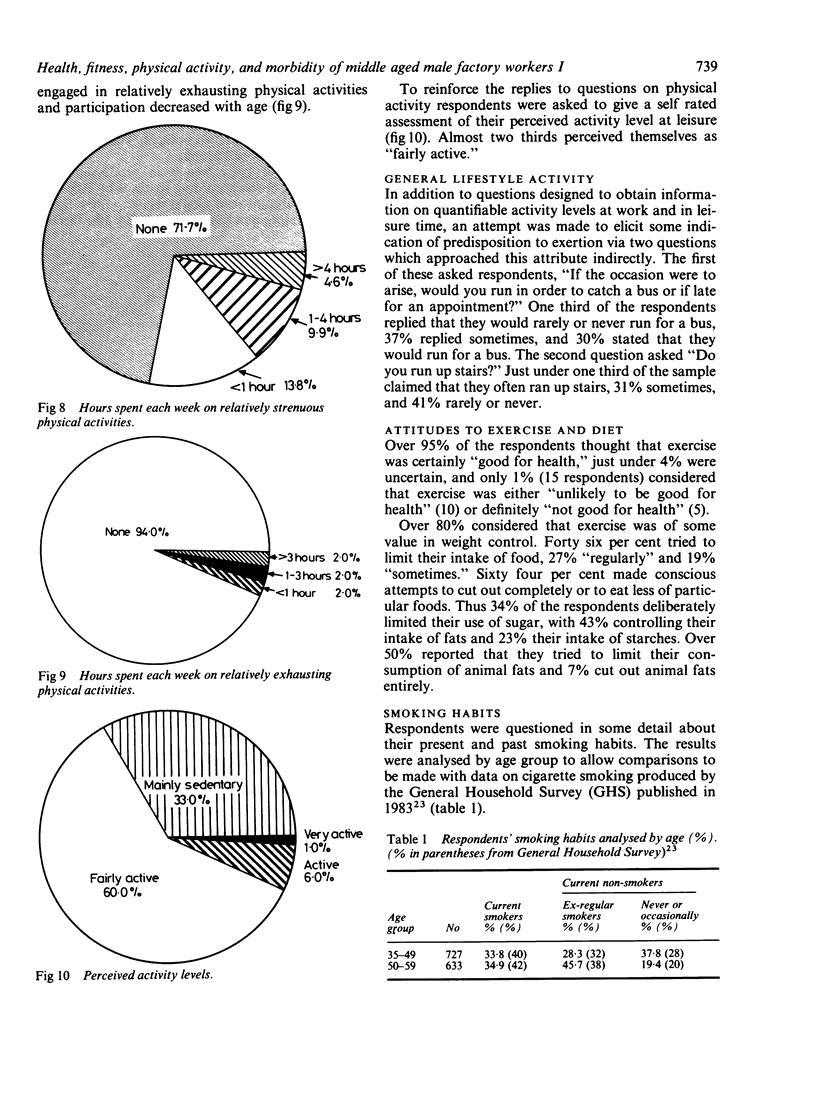
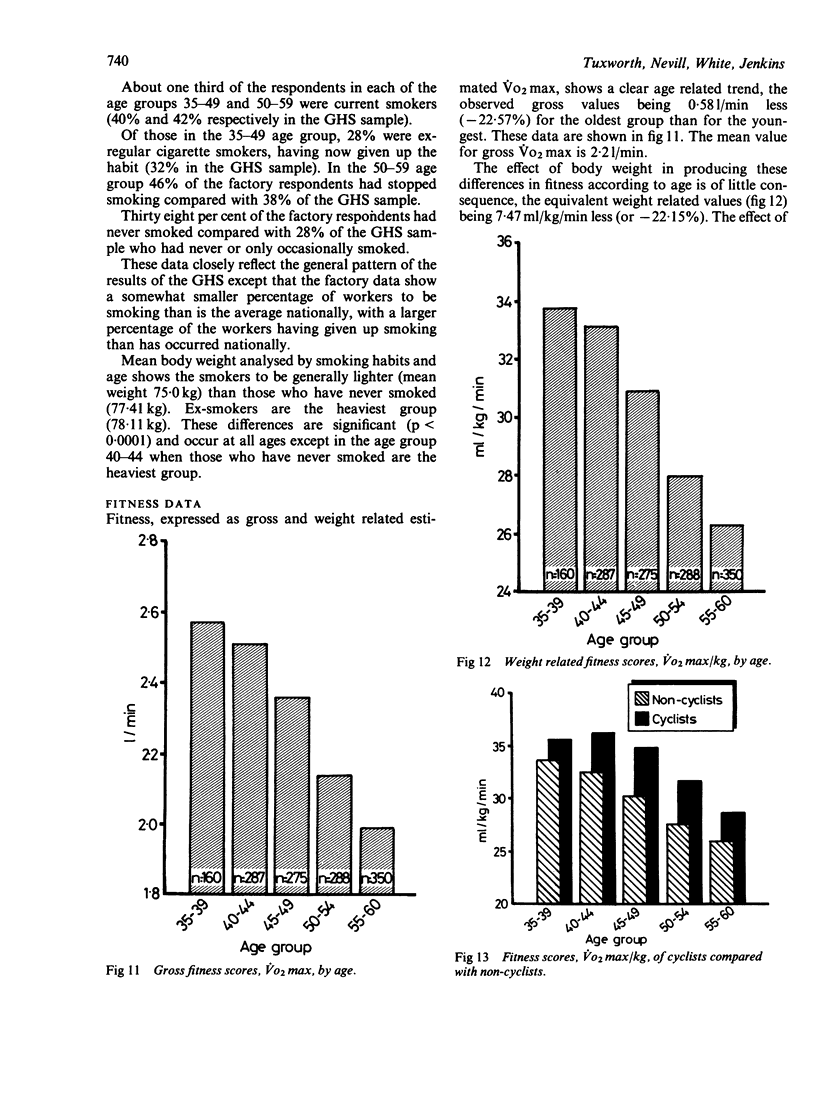
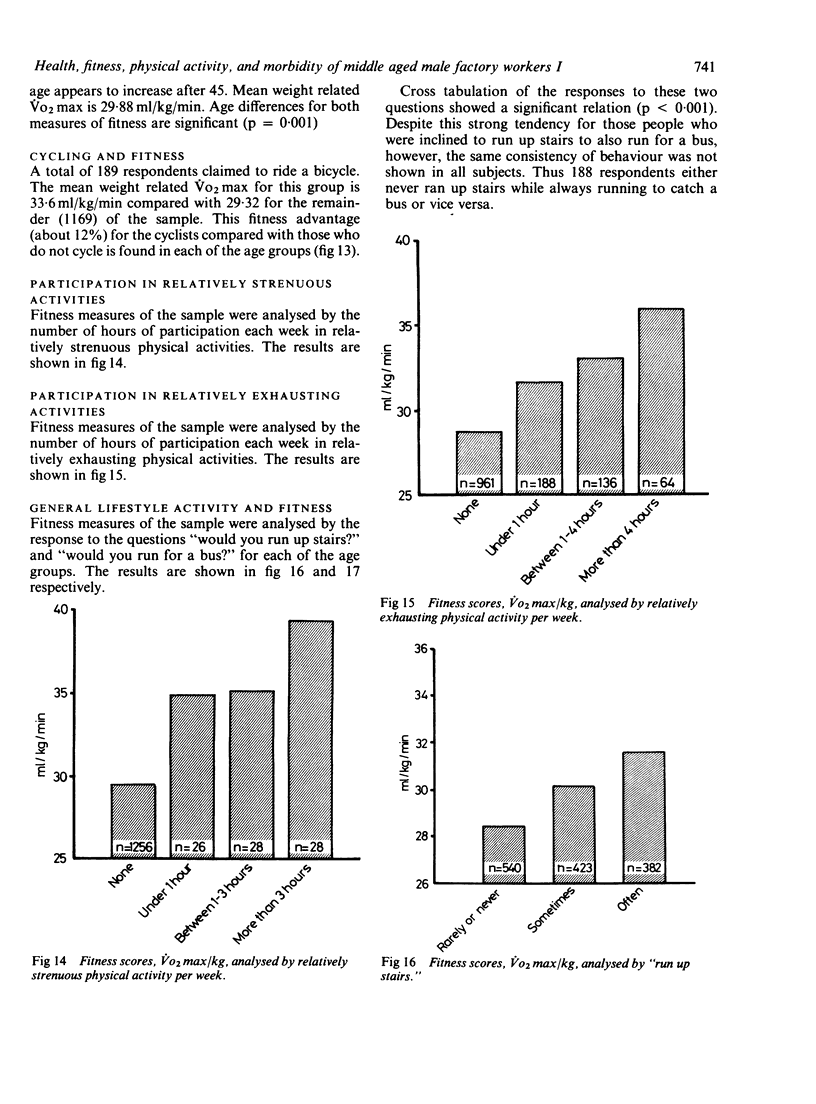

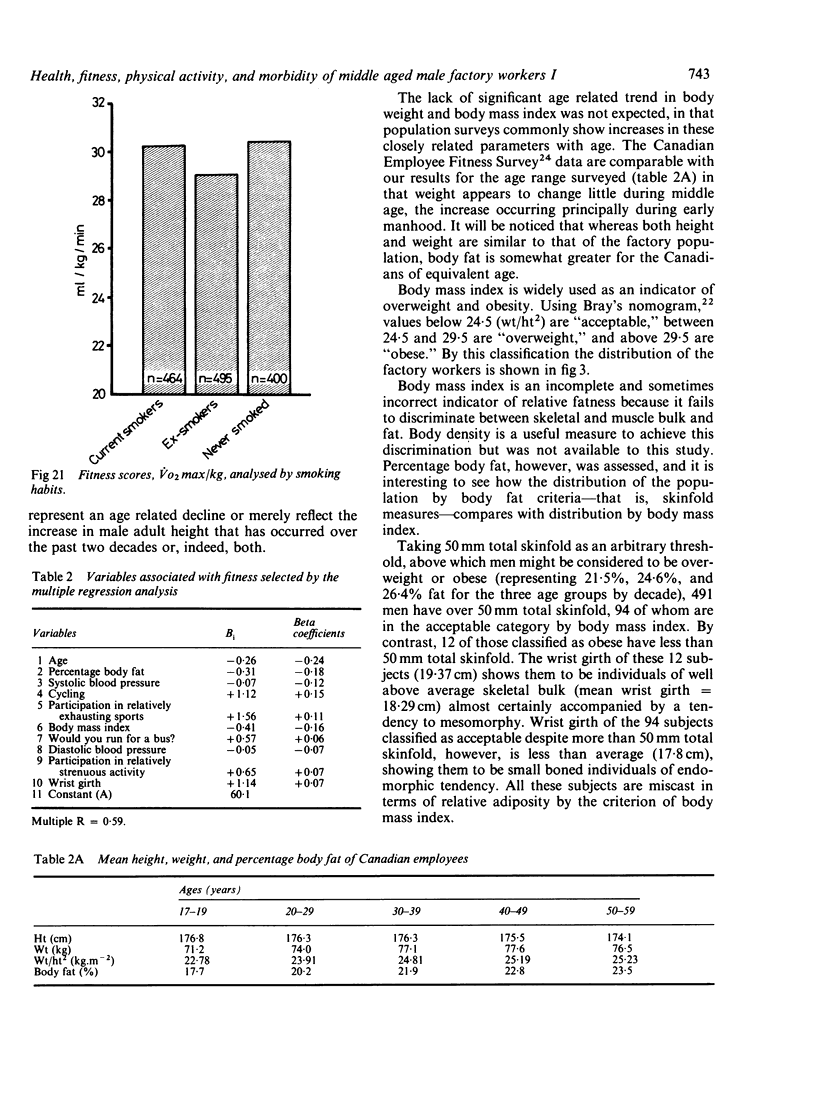



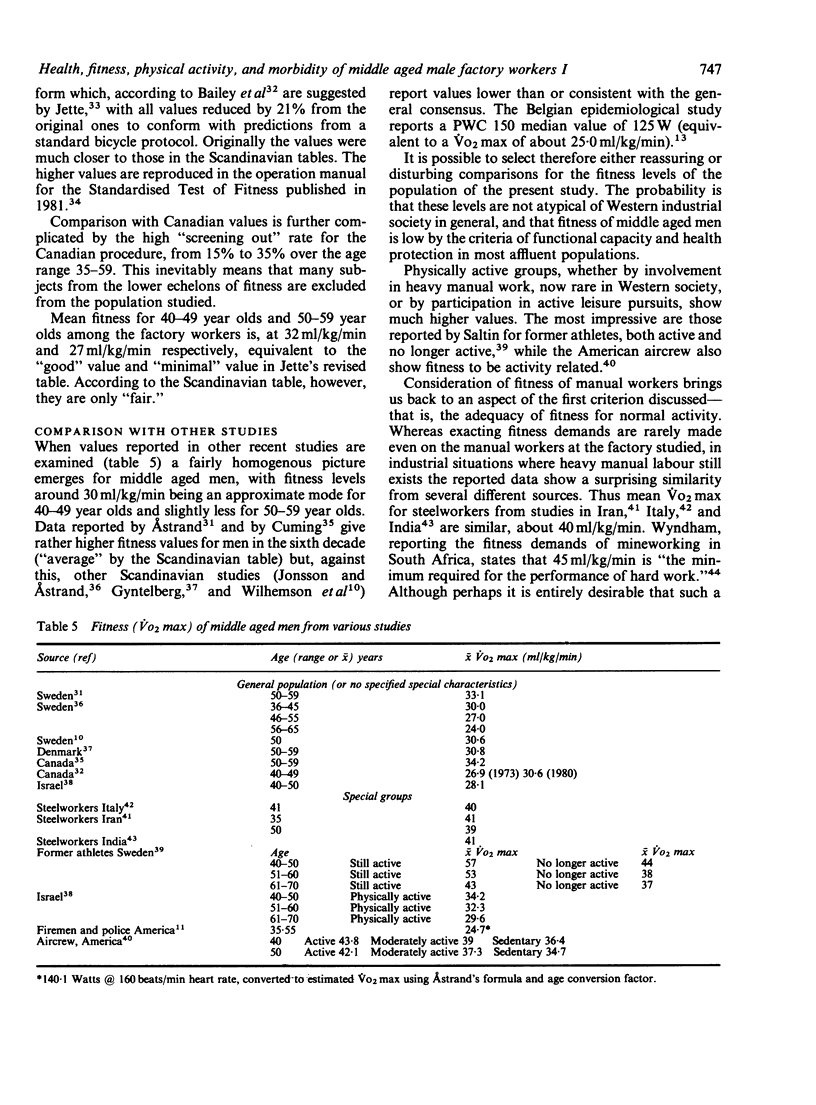

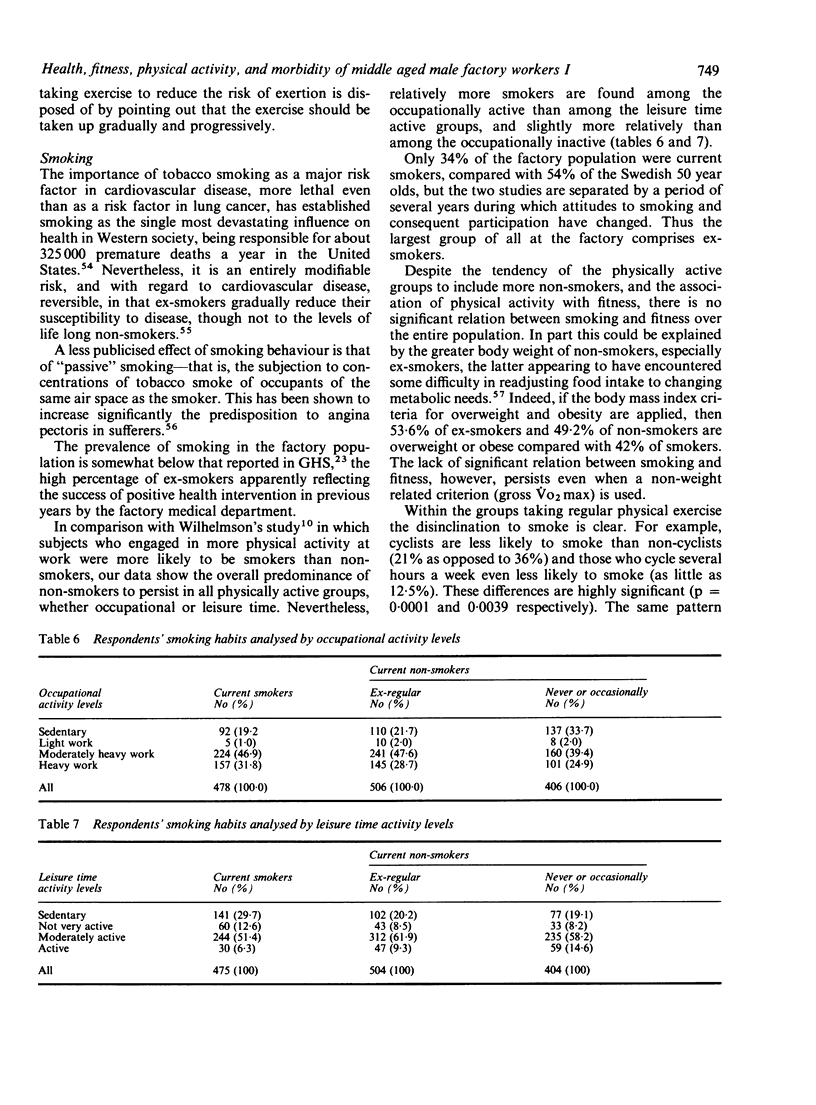

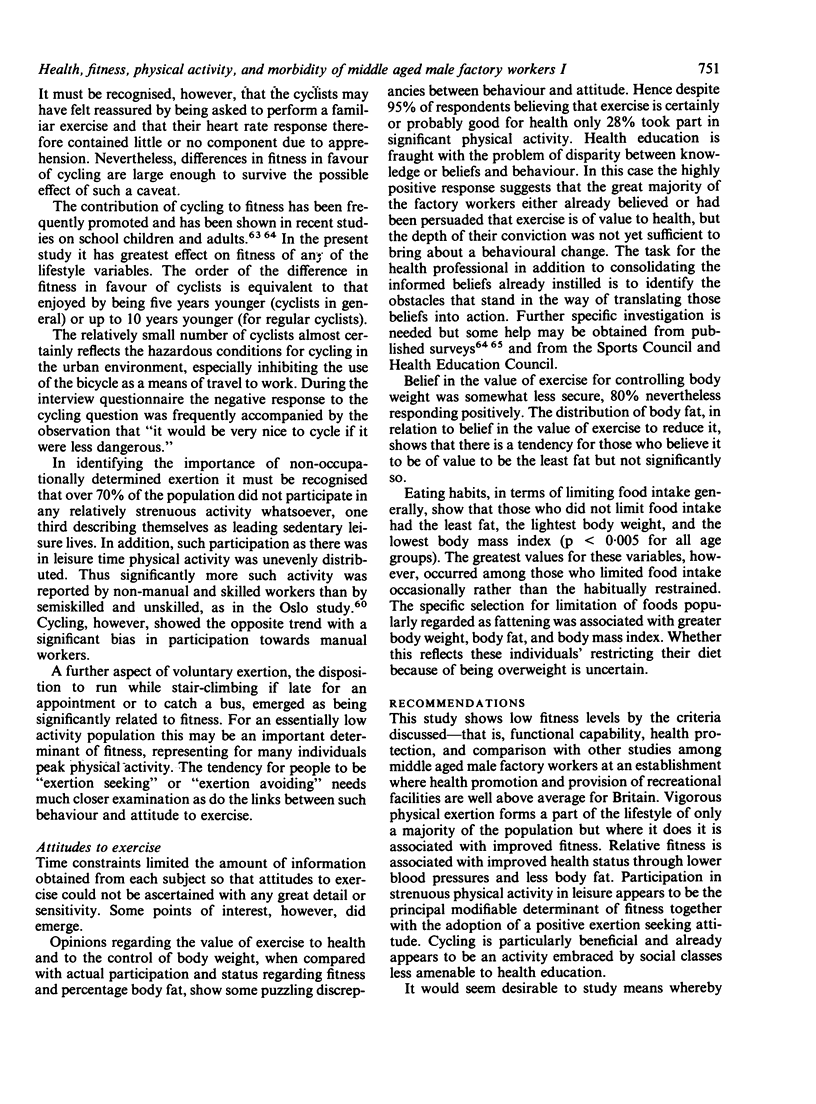
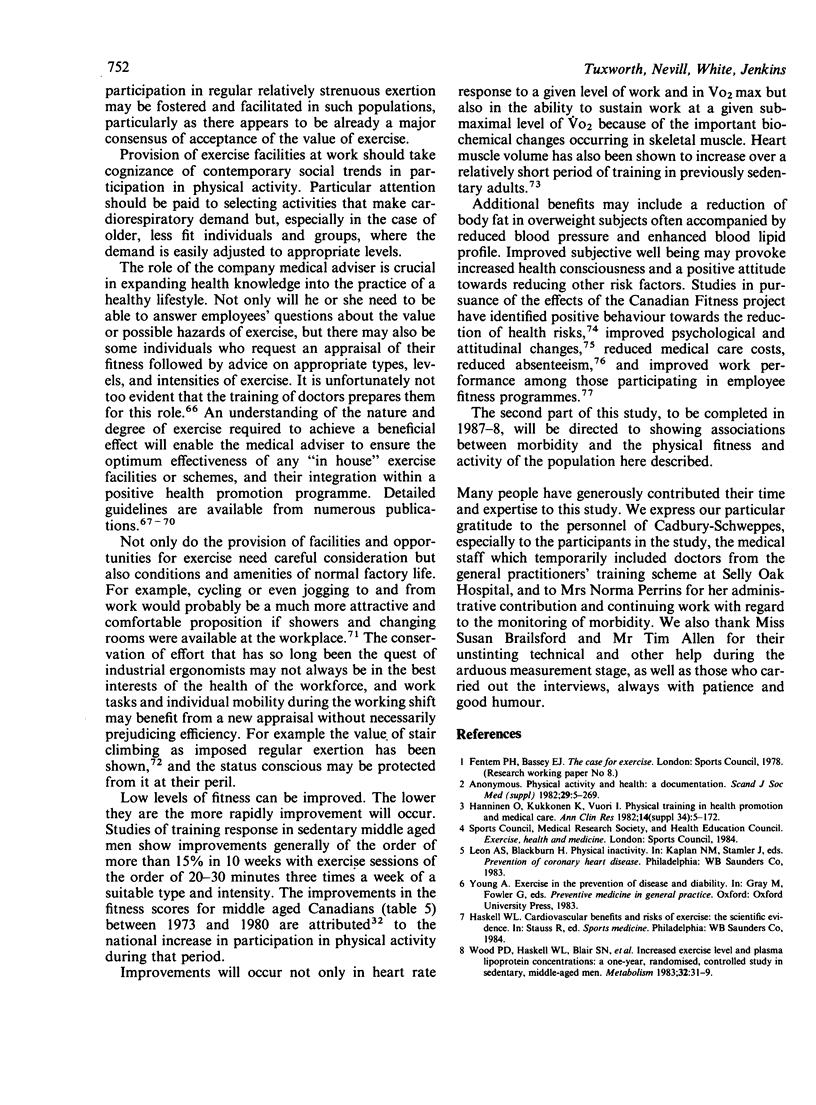
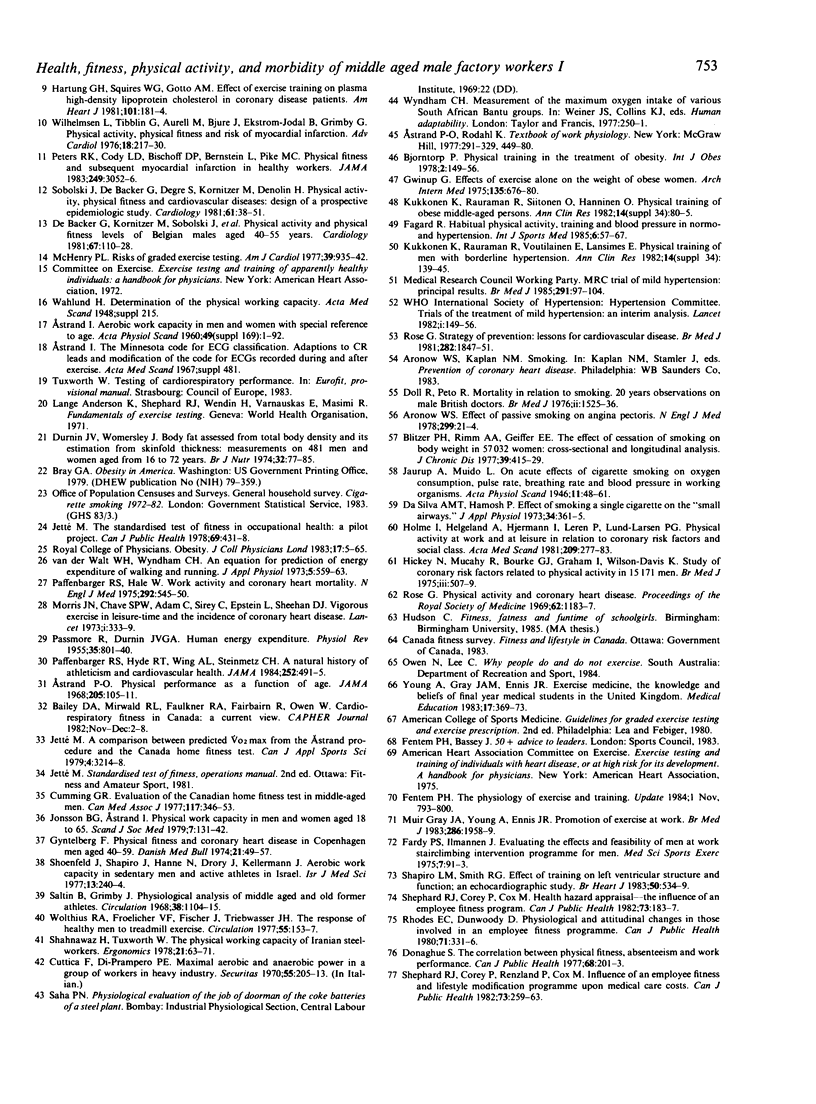
Selected References
These references are in PubMed. This may not be the complete list of references from this article.
- ASTRAND I. Aerobic work capacity in men and women with special reference to age. Acta Physiol Scand Suppl. 1960;49(169):1–92. [PubMed] [Google Scholar]
- Aronow W. S. Effect of passive smoking on angina pectoris. N Engl J Med. 1978 Jul 6;299(1):21–24. doi: 10.1056/NEJM197807062990105. [DOI] [PubMed] [Google Scholar]
- Björntorp P. Physical training in the treatment of obesity. Int J Obes. 1978;2(2):149–156. [PubMed] [Google Scholar]
- Blitzer P. H., Rimm A. A., Giefer E. E. The effect of cessation of smoking on body weight in 57,032 women: cross-sectional and longitudinal analyses. J Chronic Dis. 1977 Jul;30(7):415–429. doi: 10.1016/0021-9681(77)90035-2. [DOI] [PubMed] [Google Scholar]
- Cumming G. R., Glenn J. Evaluation of the Canadian Home Fitness Test in middle-aged men. Can Med Assoc J. 1977 Aug 20;117(4):346–349. [PMC free article] [PubMed] [Google Scholar]
- Da Silva A. M., Hamosh P. Effect of smoking a single cigarette on the "small airways". J Appl Physiol. 1973 Mar;34(3):361–365. doi: 10.1152/jappl.1973.34.3.361. [DOI] [PubMed] [Google Scholar]
- De Backer G., Kornitzer M., Sobolski J., Dramaix M., Degré S., de Marneffe M., Denolin H. Physical activity and physical fitness levels of Belgian males aged 40-55 years. Cardiology. 1981;67(2):110–128. doi: 10.1159/000173235. [DOI] [PubMed] [Google Scholar]
- Donoghue S. The correlation between physical fitness, absenteeism and work performance. Can J Public Health. 1977 May-Jun;68(3):201–203. [PubMed] [Google Scholar]
- Durnin J. V., Womersley J. Body fat assessed from total body density and its estimation from skinfold thickness: measurements on 481 men and women aged from 16 to 72 years. Br J Nutr. 1974 Jul;32(1):77–97. doi: 10.1079/bjn19740060. [DOI] [PubMed] [Google Scholar]
- Fagard R. Habitual physical activity, training, and blood pressure in normo- and hypertension. Int J Sports Med. 1985 Apr;6(2):57–67. doi: 10.1055/s-2008-1025814. [DOI] [PubMed] [Google Scholar]
- Fardy P. S., Ilmarinen J. Evaluating the effects and feasibility of an at work stairclimbing intervention program for men. Med Sci Sports. 1975 Summer;7(2):91–93. [PubMed] [Google Scholar]
- Gray J. A., Young A., Ennis J. R. Promotion of exercise at work. Br Med J (Clin Res Ed) 1983 Jun 18;286(6382):1958–1959. doi: 10.1136/bmj.286.6382.1958. [DOI] [PMC free article] [PubMed] [Google Scholar]
- Gwinup G. Effect of exercise alone on the weight of obese women. Arch Intern Med. 1975 May;135(5):676–680. [PubMed] [Google Scholar]
- Gyntelberg F. Physical fitness and coronary heart disease in Copenhagen men aged 40-59. 3. (Factors related to working capacity). Dan Med Bull. 1974 Apr;21(2):49–56. [PubMed] [Google Scholar]
- Hartung G. H., Squires W. G., Gotto A. M., Jr Effect of exercise training on plasma high-density lipoprotein cholesterol in coronary disease patients. Am Heart J. 1981 Feb;101(2):181–184. doi: 10.1016/0002-8703(81)90664-5. [DOI] [PubMed] [Google Scholar]
- Hickey N., Mulcahy R., Bourke G. J., Graham I., Wilson-Davis K. Study of coronary risk factors related to physical activity in 15 171 men. Br Med J. 1975 Aug 30;3(5982):507–509. doi: 10.1136/bmj.3.5982.507. [DOI] [PMC free article] [PubMed] [Google Scholar]
- Holme I., Helgeland A., Hjermann I., Leren P., Lund-Larsen P. G. Physical activity at work and at leisure in relation to coronary risk factors and social class. A 4-year mortality follow-up. The Oslo study. Acta Med Scand. 1981;209(4):277–283. doi: 10.1111/j.0954-6820.1981.tb11591.x. [DOI] [PubMed] [Google Scholar]
- Jetté M. The standardized test of fitness in occupational health: a pilot project. Can J Public Health. 1978 Nov-Dec;69(6):431–438. [PubMed] [Google Scholar]
- Jonsson B. G., Astrand I. Physical work capacity in men and women aged 18 to 65. Scand J Soc Med. 1979;7(3):131–142. doi: 10.1177/140349487900700306. [DOI] [PubMed] [Google Scholar]
- Kukkonen K., Rauramaa R., Siitonen O., Hänninen O. Physical training of obese middle-aged persons. Ann Clin Res. 1982;14 (Suppl 34):80–85. [PubMed] [Google Scholar]
- Kukkonen K., Rauramaa R., Voutilainen E., Länsimies E. Physical training of middle-aged men with borderline hypertension. Ann Clin Res. 1982;14 (Suppl 34):139–145. [PubMed] [Google Scholar]
- McHenry P. L. Risks of graded exercise testing. Am J Cardiol. 1977 May 26;39(6):935–937. doi: 10.1016/s0002-9149(77)80049-0. [DOI] [PubMed] [Google Scholar]
- Morris J. N., Chave S. P., Adam C., Sirey C., Epstein L., Sheehan D. J. Vigorous exercise in leisure-time and the incidence of coronary heart-disease. Lancet. 1973 Feb 17;1(7799):333–339. doi: 10.1016/s0140-6736(73)90128-1. [DOI] [PubMed] [Google Scholar]
- PASSMORE R., DURNIN J. V. Human energy expenditure. Physiol Rev. 1955 Oct;35(4):801–840. doi: 10.1152/physrev.1955.35.4.801. [DOI] [PubMed] [Google Scholar]
- Paffenbarger R. S., Hale W. E. Work activity and coronary heart mortality. N Engl J Med. 1975 Mar 13;292(11):545–550. doi: 10.1056/NEJM197503132921101. [DOI] [PubMed] [Google Scholar]
- Paffenbarger R. S., Jr, Hyde R. T., Wing A. L., Steinmetz C. H. A natural history of athleticism and cardiovascular health. JAMA. 1984 Jul 27;252(4):491–495. [PubMed] [Google Scholar]
- Peters R. K., Cady L. D., Jr, Bischoff D. P., Bernstein L., Pike M. C. Physical fitness and subsequent myocardial infarction in healthy workers. JAMA. 1983 Jun 10;249(22):3052–3056. [PubMed] [Google Scholar]
- Physical training in health promotion and medical care. Ann Clin Res. 1982;14 (Suppl 34):5–172. [PubMed] [Google Scholar]
- Rhodes E. C., Dunwoody D. Physiological and attitudinal changes in those involved in an employee fitness program. Can J Public Health. 1980 Sep-Oct;71(5):331–336. [PubMed] [Google Scholar]
- Rose G. Physical activity and coronary heart disease. Proc R Soc Med. 1969 Nov;62(11 Pt 2):1183–1188. [PMC free article] [PubMed] [Google Scholar]
- Rose G. Strategy of prevention: lessons from cardiovascular disease. Br Med J (Clin Res Ed) 1981 Jun 6;282(6279):1847–1851. doi: 10.1136/bmj.282.6279.1847. [DOI] [PMC free article] [PubMed] [Google Scholar]
- Shahnawaz H., Tuxworth W. The physical working capacity of Iranian steel-workers. Ergonomics. 1978 Jan;21(1):63–71. doi: 10.1080/00140137808931694. [DOI] [PubMed] [Google Scholar]
- Shapiro L. M., Smith R. G. Effect of training on left ventricular structure and function. An echocardiographic study. Br Heart J. 1983 Dec;50(6):534–539. doi: 10.1136/hrt.50.6.534. [DOI] [PMC free article] [PubMed] [Google Scholar]
- Shephard R. J., Corey P., Cox M. Health hazard appraisal--the influence of an employee fitness program. Can J Public Health. 1982 May-Jun;73(3):183–187. [PubMed] [Google Scholar]
- Shephard R. J., Corey P., Renzland P., Cox M. The influence of an employee fitness and lifestyle modification program upon medical care costs. Can J Public Health. 1982 Jul-Aug;73(4):259–263. [PubMed] [Google Scholar]
- Shoenfeld Y., Shapiro Y., Hanne N., Drory Y., Kellermann J. J. Aerobic work capacity in sedentary men and active athletes in Israel. Isr J Med Sci. 1977 Mar;13(3):240–244. [PubMed] [Google Scholar]
- Sobolski J., de Backer G., Degre S., Kornitzer M., Denolin H. Physical activity, physical fitness and cardiovascular diseases: design of a prospective epidemiologic study. Cardiology. 1981;67(1):38–51. doi: 10.1159/000173227. [DOI] [PubMed] [Google Scholar]
- Wessler S., Avioli L. V. The parathyroid adenoma. JAMA. 1968 Jul 1;205(1):105–109. doi: 10.1001/jama.205.1.105. [DOI] [PubMed] [Google Scholar]
- Wilhelmsen L., Tibblin G., Aurell M., Bjure J., Ekström-Jodal B., Grimby G. Physical activity, physical fitness and risk of myocardial infarction. Adv Cardiol. 1976;18(0):217–230. doi: 10.1159/000399526. [DOI] [PubMed] [Google Scholar]
- Wolthuis R. A., Froelicher V. F., Jr, Fischer J., Triebwasser J. H. The response of healthy men to treadmill exercise. Circulation. 1977 Jan;55(1):153–157. doi: 10.1161/01.cir.55.1.153. [DOI] [PubMed] [Google Scholar]
- Young A., Gray J. A., Ennis J. R. 'Exercise medicine': the knowledge and beliefs of final-year medical students in the United Kingdom. Med Educ. 1983 Nov;17(6):369–373. doi: 10.1111/j.1365-2923.1983.tb01122.x. [DOI] [PubMed] [Google Scholar]
- van der Walt W. H., Wyndham C. H. An equation for prediction of energy expenditure of walking and running. J Appl Physiol. 1973 May;34(5):559–563. doi: 10.1152/jappl.1973.34.5.559. [DOI] [PubMed] [Google Scholar]


